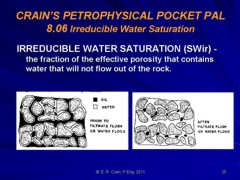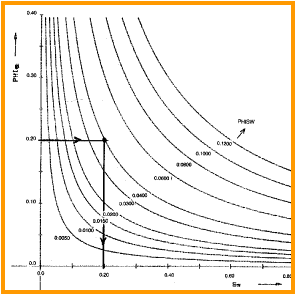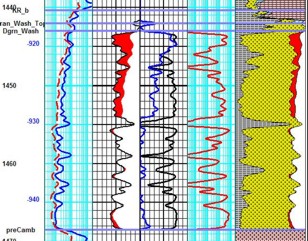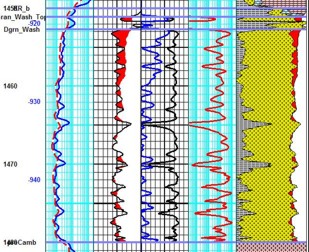|
SWir is equivalent to the minimum water saturation found from capillary pressure curves determined from special core analysis. Typical capillary pressure curve relationships are shown below.
The difference between Sw and SWir, and relative permeability of water and hydrocarbon, determine the water cut. These concepts are best described by the capillary pressure curve and relative permeability curves illustrated above.
Irreducible water saturation is a necessary value for water cut and permeability calculations.
STEP 1: Find Buckles number from special core analysis or from log analysis in a known clean pay zone that produced initially with zero water cut. 1: KBUCKL = PHIe * Sw (in a CLEAN zone that produced initially with no water, or from core data)
STEP 2: Solve for irreducible water saturation in each zone. 2: IF zone is obviously hydrocarbon bearing 3: THEN SWir = Sw 4: OTHERWISE SWir = KBUCKL / PHIe / (1 – Vsh) 5: IF SWir > Sw 6: THEN SWir = Sw
An easier,
but equivalent, model is:
Reference:
· Buckles Number can be found by observing the porosity times water saturation product in pay zones where RW@FT is known, or where a water zone can be used to calibrate RW@FT. Data can also be found from capillary pressure data.
· If Sw is greater than SWir, then the zone will produce with some water cut (if it produces anything at all).
· If Sw is less than SWir, then the Buckles number for the layer is wrong.
· The (1 – Vsh) term can be replaced by (1 – Vsh^2) if needed.
· Calibrate water saturation to core by preparing a porosity vs SWir graph from capillary pressure data. Adjust KBUCKL, Vsh, PHIe until a satisfactory match is achieved.
Sandstones Carbonates KBUCKL Very fine grain Chalky 0.120 Fine grain Cryptocrystalline 0.060 Medium grain Intercrystalline 0.030 Coarse grain Sucrosic 0.020 Conglomerate Fine vuggy 0.010 Unconsolidated Coarse vuggy 0.005 Fractured Fractured 0.001
The NMR transform is illustrated below. The matrix and dry clay terms of NMR response are zero. An NMR log run today can display clay bound water (CBW), irreducible water (capillary bound water, BVI), and mobile fluids (hydrocarbon plus water, BVM), also called free fluids or free fluid index (FFI). On older logs, only free fluids (FFI) is recorded and some subtractions, based on other open hole logs, are required.
Nuclear Magnetic Resonance Response to Fluids
7: PHIt = CBW + BVI + BVM 8: PHIe = BVI + BVM
9: SWir = BVI /
(BVI + BVM)
Some or all of the sums defined above may be displayed on the delivered log. Log presentation is far from standard for NMR logs. PHIt and PHIe from NMR do not always agree with that derived from density neutron methods, which see much larger volumes of rock.
For older logs, the BVI measurement was not
possible, so:
|
||
|
Page Views ---- Since 01 Jan 2015
Copyright 2023 by Accessible Petrophysics Ltd. CPH Logo, "CPH", "CPH Gold Member", "CPH Platinum Member", "Crain's Rules", "Meta/Log", "Computer-Ready-Math", "Petro/Fusion Scripts" are Trademarks of the Author |
||


|
||
| Site Navigation | PERMEABILITY IRREDUCIBLE WATER SATURATION | Quick Links |





